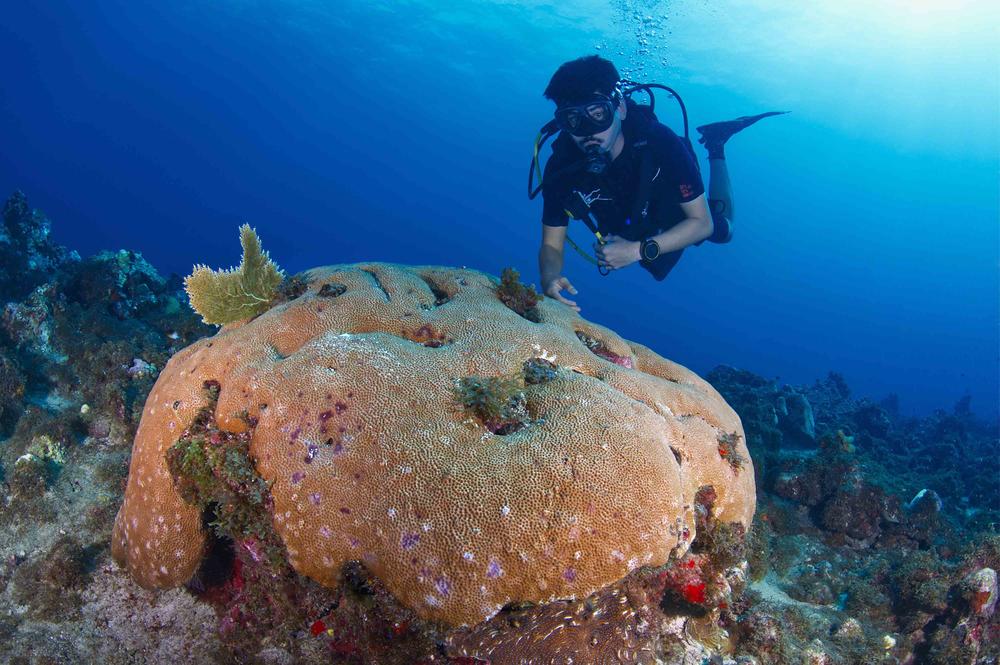Endangered Reefs
Resilient corals are vital to preserving marine life. How much longer do they have? Researchers at Freie Universität Berlin explore the possible lessons we can learn from the ocean’s memory.
Oct 27, 2025
While scuba diving at the Caye d’Olbian reef, Martinique, Gabriel Cardoso encountered very few massive Siderastrea siderea coral that were still alive.
Image Credit: Ewan Trégarot
Small animals, barely visible to the naked eye, live in colonies underwater, build skeletons out of calcium carbonate: This thumbnail sketch of stony corals does not make them sound like big players on the global stage, but these little creatures are vital to preserving a habitable environment for many organisms in our oceans. One quarter of all ocean species rely on coral reefs for food and shelter, which is all the more impressive given that coral reefs cover less than one percent of the ocean floor. They also play an important role in supporting human life. On the one hand, the fishing industry depends on the diversity of fish that live on reefs, while the bright colorful reefs attract people from around the world, making them a significant source of revenue for tourism. On the other hand, coral reefs are natural barriers that help stabilize coastlines and protect humans from storms and waves. But the climate crisis and human influences on the environment are putting corals at risk. “Even stress-tolerant coral species are finding it difficult to adapt to these changes,” says Gabriel Cardoso, a doctoral researcher in paleoecology at Freie Universität Berlin.
Cardoso is writing his doctoral thesis on how corals respond to changes in the environment. He has also conducted research on Siderastrea siderea corals using samples collected off the coast of Martinique. This coral is reddish-brown, grows in colonies, and can reach a few meters in size. It is considered one of the most resilient species of its kind and is ubiquitous in the coral reefs of Martinique.
Corals Are in Danger
An ocean reef is actually made up of many different species of corals. Pollution, disease, and rising ocean temperatures have led to shrinking numbers of certain types of corals, particularly the Acropora spp. corals, more sensitive species that grow rapidly (one to two centimeters per year). But current research shows that the Siderastrea siderea, which grows three to four times slower than Acropora spp. corals, is also in danger.
“This kind of coral is a survivor. Unfortunately, our findings suggest that even this super resilient species has its limits,” says Cardoso. During a research trip to Martinique, he was surprised by what he saw underwater: “There were so many dead corals. Living colonies of large corals were scattered sparsely about the reef.” Together with a team of international scientists, Cardoso studied the Siderastrea siderea and its growthover the last 100 years.
Cardoso explains that it is the mix of global and local factors that endanger corals. On the global scale, rising temperatures are the greatest threat to corals. Marine heat waves are a direct cause of coral mortality. Ocean acidification is also a major threat to corals. “At the local level, overfishing, coastal pollution, and coral diseases are contributing to the deterioration of coral reefs,” says Cardoso.
Excavation of harbors, clear-cutting, and intensive land-use are also local stressors. Pesticides and fertilizers used in agriculture that wash into the sea contribute to coastal pollution and the spread of coral disease. “All in all, the problem can be traced back to changes caused by human actions,” Cardoso says.
Thanks to the special characteristics of corals, the team of researchers were able to reconstruct the history of Siderastrea siderea’s growth in Martinique over the last 100 years. The calcium carbonate skeleton that corals produce, which makes up the foundation of the reef, is incredibly durable and can remain intact for extended periods of time.
The Ocean’s Memory
“In the Caribbean there are coral colonies over 600 years old. But reefs have been growing there for millions and millions of years. The structure of the Great Barrier Reef is actually some 700,000 years old,” Cardoso explains. Like the rings of a tree, coral “cores” can be used to gauge the age of the corals. Researchers can also analyze them to extract information about climate change and water temperatures in the past. Indeed, coral skeletons act as a natural archive that store historical data about the environment.
To access this information, the team of scientists had to dive down to the Siderastrea siderea corals, four to thirteen meters below sea level. Using specialized drilling instruments, they were able to carefully extract a coral core, which was then transported back to Germany where it was x-rayed and analyzed using geochemical methods.
“The way corals allow us to travel back through time is really quite unique,” says Cardoso. “We are able to find out what they experienced, which species swam through them and how many of them there were.” Today, for example, sea bream and humpback whales swim past Siderastrea siderea corals. The now extinct Caribbean monk seal also used to frequent them.
Gabriel Cardoso is a paleoecologist, working on his doctorate at Freie Universität Berlin.
Image Credit: Jan Kersten
What Can Be Done to Counteract these Threats?
The loss of coral reef is not just noticeable in the waters of Martinique; it is happening throughout the Caribbean. Something has to be done, says Cardoso, and fast! Given the fact that the threats to corals are coming from multiple levels, the countermeasures must follow suit. That means, for example, tackling the climate crisis on a global level, while also promoting conservation and environmental protection on a local level.
Cardoso mentions a few clear measures: “No fishing during breeding/spawning season, no bottom trawling with nets that destroys the coral reef, and keep pesticides from running into the ocean.” It is also important to pay attention to neighboring ecosystems. “For example, if a storm hits Martinique, a healthy coral reef can protect the seagrass meadows and mangrove forests behind it,” Cardoso says. In fact, it goes both ways – they protect each other. Mangroves also protect corals by trapping sediment from coastal runoff that could otherwise smother the corals.
A holistic approach to environmental management and conservation demands coordinating measures with local communities and governments. Cardoso developed a model for the fishing industry and local governments as part of his work on the project “Marine Coastal Ecosystems Biodiversity and Services in a Changing World.” The model is a user-friendly software tool that shows just how efficient and beneficial ecological protection measures can be.
The project was funded by the European Union’s Horizon 2020 program and headed by paleontologist and geobiologist Professor Reinhold Leinfelder together with geologist Dr. Georg Heiss. The team of researchers included Juan Pablo D’Olivo Cordero, Diego Kersting, Marina Vergotti, as well as Cardoso himself.
After finishing his doctorate, Cardoso hopes to find ways to combine his scientific expertise with practical problem-solving. He would like to continue studying corals: “The more we know about corals – how they grow and how to protect them – the better equipped we are to understand the fundamental question of how to preserve biodiversity in the oceans.”
This article originally appeared in German in the Tagesspiegel newspaper supplement published by Freie Universität Berlin.


